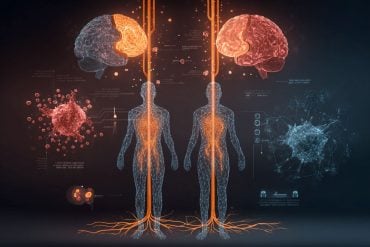Summary: Study reports the balance between serotonin and dopamine may be a risk factor for a person developing social anxiety disorder.
Source: Uppsala University
The balance between the neurotransmitters serotonin and dopamine may affect whether a person develops social anxiety disorder. Previous research has mainly focused on either the serotonin or the dopamine system individually. Now researchers at Uppsala University have demonstrated the existence of a previously unknown link between the two. The results are published in Molecular Psychiatry.
“We see that there is a different balance between serotonin and dopamine transport in people with social anxiety disorder compared with control subjects. The interaction between serotonin and dopamine transport explained more of the difference between the groups than each carrier individually. This suggests one should not focus exclusively on one signal substance at a time, the balance between different systems may be more important,” says Olof Hjorth, Ph.D. student at the Department of Psychology at Uppsala University, Sweden.
Social anxiety can be a highly debilitating psychiatric disorder with negative impacts on the individual’s relationships and working life. This study shows that affected people may have an imbalance between the serotonin and dopamine transporters in the amygdala and other brain areas that are important for fear, motivation and social behavior. The functioning of the brain’s signal substances is affected by the amount of reuptake by the transmitter cell, which is controlled by specific transporter proteins.
“Previously, we have found an increased production and altered reuptake of serotonin in sufferers of social anxiety disorder, a finding we now, in part, replicate,” says Hjorth. He adds, “We can now show that dopamine reuptake is also directly related to the severity of the social anxiety symptoms that the individual is experiencing.”
The method used in the study is called positron emission tomography (PET), in which radioactive agents, injected into the blood stream, decay and release a signal that allows the scientists to determine the density of available transporter proteins in different areas of the brain.

The researchers hope that the current findings can lead to a better understanding of the causes of social anxiety and ultimately to new, more effective treatments.
“Many of the patients we meet have symptoms that affect all parts of their everyday life, and many of them have suffered for most of their lives, so understanding the cause and finding effective treatments are our highest priority,” says Hjorth.
Source:
Uppsala University
Media Contacts:
Olof Hjorth – Uppsala University
Image Source:
The image is in the public domain.
Original Research: Closed access
“Expression and co-expression of serotonin and dopamine transporters in social anxiety disorder: a multitracer positron emission tomography study”. Olof R. Hjorth, Andreas Frick, Malin Gingnell, Johanna M. Hoppe, Vanda Faria, Sara Hultberg, Iman Alaie, Kristoffer N. T. Månsson, Kurt Wahlstedt, My Jonasson, Mark Lubberink, Gunnar Antoni, Mats Fredrikson & Tomas Furmark.
Molecular Psychiatry doi:10.1038/s41380-019-0618-7.
Abstract
Expression and co-expression of serotonin and dopamine transporters in social anxiety disorder: a multitracer positron emission tomography study
Serotonin and dopamine are putatively involved in the etiology and treatment of anxiety disorders, but positron emission tomography (PET) studies probing the two neurotransmitters in the same individuals are lacking. The aim of this multitracer PET study was to evaluate the regional expression and co-expression of the transporter proteins for serotonin (SERT) and dopamine (DAT) in patients with social anxiety disorder (SAD). Voxel-wise binding potentials (BPND) for SERT and DAT were determined in 27 patients with SAD and 43 age- and sex-matched healthy controls, using the radioligands [11C]DASB (3-amino-4-(2-dimethylaminomethylphenylsulfanyl)-benzonitrile) and [11C]PE2I (N-(3-iodopro-2E-enyl)-2beta-carbomethoxy-3beta-(4′-methylphenyl)nortropane). Results showed that, within transmitter systems, SAD patients exhibited higher SERT binding in the nucleus accumbens while DAT availability in the amygdala, hippocampus, and putamen correlated positively with symptom severity. At a more lenient statistical threshold, SERT and DAT BPND were also higher in other striatal and limbic regions in patients, and correlated with symptom severity, whereas no brain region showed higher binding in healthy controls. Moreover, SERT/DAT co-expression was significantly higher in SAD patients in the amygdala, nucleus accumbens, caudate, putamen, and posterior ventral thalamus, while lower co-expression was noted in the dorsomedial thalamus. Follow-up logistic regression analysis confirmed that SAD diagnosis was significantly predicted by the statistical interaction between SERT and DAT availability, in the amygdala, putamen, and dorsomedial thalamus. Thus, SAD was associated with mainly increased expression and co-expression of the transporters for serotonin and dopamine in fear and reward-related brain regions. Resultant monoamine dysregulation may underlie SAD symptomatology and constitute a target for treatment.






